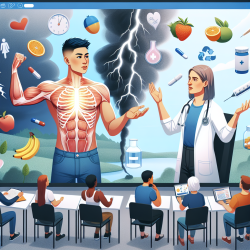Introduction
In the realm of speech-language pathology and therapeutic interventions, understanding the multifaceted relationship between mental health markers and physical pain is paramount. A recent study titled "Mental health markers and protective factors in students with symptoms of physical pain across WEIRD and non-WEIRD samples – a network analysis" sheds light on this intricate interaction, offering valuable insights for practitioners aiming to enhance their skills and improve outcomes for children.
Key Findings from the Study
The study, conducted across university students in Switzerland (WEIRD) and India (non-WEIRD), utilized network analysis to explore the connections between mental health markers such as anxiety, depression, PTSD, and perceived stress, and protective factors like social support and self-efficacy. The results revealed several critical insights:
- Anxiety: Identified as the most central mental health marker associated with physical pain in both Swiss and Indian students.
- Social Support: Emerged as the most significant protective factor, highlighting its role in mitigating physical pain symptoms.
- Cultural Differences: While anxiety was central in both contexts, perceived stress was more prominent in Swiss students, whereas PTSD was more central among Indian students.
Implications for Practitioners
For practitioners in the field of speech-language pathology and related therapeutic disciplines, these findings underscore the importance of culturally sensitive interventions. Here are some actionable insights:
- Target Anxiety: Given its central role, interventions that address anxiety could be crucial in reducing physical pain symptoms. Techniques such as cognitive-behavioral therapy and mindfulness-based stress reduction can be effective.
- Enhance Social Support: Encourage the development of robust social support networks for children and young adults. This can involve family therapy sessions and community engagement activities.
- Cultural Sensitivity: Tailor interventions to account for cultural differences in mental health markers. For instance, focus on managing perceived stress in Swiss contexts and addressing PTSD symptoms in Indian settings.
Encouraging Further Research
While this study provides a foundational understanding, it also highlights the need for further research, particularly in non-WEIRD contexts. Practitioners are encouraged to contribute to this growing body of knowledge by conducting localized studies and sharing findings within the professional community.
Conclusion
By integrating these research insights into practice, speech-language pathologists and therapists can enhance their effectiveness in addressing the complex interplay between mental health and physical pain. This approach not only improves therapeutic outcomes but also contributes to the overall well-being of children and young adults.
To read the original research paper, please follow this link: Mental health markers and protective factors in students with symptoms of physical pain across WEIRD and non-WEIRD samples – a network analysis.










